Pitch Location and Swing Angles: Dunn and Bruce
Last Thursday, I took a stab at predicting how batter’s swing influences their ground ball / fly ball splits. One of the most important retorts to the research (a retort made both in the comments and on The Book blog) was that pitch location was the determining factor of bat angles — what I was attributing to hitter tendencies (at least for hitters who have big GB/FB platoon splits).
Consider today’s offering a second puzzle piece — hopefully an edge piece — in what is a 1000-piece puzzle of understanding GB/FB splits. Today I offer the case study of two (essentially randomly picked) hitters with large GB/FB platoon — Adam Dunn and Jay Bruce.
The results surprised me, twice, and in the end, it appears these two hitters employ different swing patterns, suggesting there may be traction with my original theory, even though pitch location does have a considerable affect on swing angles.
Why Bruce and Dunn? Well, if we refer to the dataset Jeff Zimmerman helped me put together in the first article — and limit the players to those with 300 PA — we find there are two obvious candidates for this study: Adam Dunn and Derek Jeter. But Jeter is a no go.
Dunn hits ground ballers well — even if we cross-reference my numbers with Baseball-Reference GB/FB splits — and so we should expect an uppercut or at least uppercuttish swing from him. He has a .400 wOBA against ground ballers over the last three years, a .315 wOBA against neutral pitchers and a .327 wOBA against fly ball pitchers.
Jeter has a .302 wOBA, .330 wOBA and .353 wOBA against GB, neutral and FB pitchers — a perfect balance to Dunn!
But here’s the deal; this is a plot of Jeter’s home runs this year:

Yeah, Jeter’s results are almost definitely going to be rich with large, level angles. But that is because Jeter is clearly a high-ball hitter, not necessarily a hitter stuck using one swing angle / swing plane*, like my theory suggest some players are. So we have to enter this bit of information into our calculus, and keep moving because he is essentially useless for today’s purposes.
* I used the term “swing planes” in the original article, but since I was essentially redefining the means of measuring a swing plane, I think it is useful for clarity purposes to call it “swing angles” — so please, dear friends, do not worry about telling me how to measure swing planes; I know how to do it; I’m not doing it the old way on purpose.
That is not to say we throw out the Jeter data. No, we enter it into our mind computers and write down in pencil: Some guys may succeed against fly ball pitchers because they are high-ball hitters. This is neither a surprising suggestion or even a suggesting that damns my initial theory of swing angles.
But it does mean we need a different hitter. So we move on to Jay Bruce of the Reds. Bruce has a .338/.337/.384 wOBA GB/NU/FB distribution, making him another strong fly ball hitter with a lot of evidence to suggest its a real, legit skill for him. And, more importantly, he has not only home runs all ovah the place, but he has home runs aplenty.
So let us start with Bruce. Here are his home runs (as of Tuesday):

And here are the angles I recorded for his highest and lowest homers (6 high, 7 low):
| Homer | Height (pz) | Bat Angle | HR Date |
|---|---|---|---|
| 1 | 3.81 | 62° | 4/26/2012 |
| 2 | 3.30 | 67° | 4/28/2012 |
| 3 | 3.22 | 64° | 9/2/2012 |
| 4 | 3.13 | 59° | 8/15/2012 |
| 5 | 2.88 | 55° | 8/12/2012 |
| 6 | 2.85 | 65° | 5/4/2012 |
| 7 | 2.81 | 58° | 9/3/2012 |
| 8 | 2.15 | 45° | 5/27/2012 |
| 9 | 2.00 | 52° | 5/7/2012 |
| 10 | 1.97 | 50° | 6/16/2012 |
| 11 | 1.94 | 50° | 4/8/2012 |
| 12 | 1.84 | 53° | 9/4/2012 |
| 13 | 1.63 | 55° | 4/8/2012 |
Ideally, I would have all 32 of Bruce’s homers in that chart — heck, all 132 homers of his career — but like I said, this is just another piece of the puzzle. I heartily encourage anyone interested in filling in data where my spreadsheets are left blank.
But for today, this 13 homers should be good enough.
One of the key components of understanding my swing angle theory is that we need to look at the full, typical swing, not just the bat angle at the point of contact. As I noted with A.J. Pierzynski in the first article, some bat angles may be low, but the follow-through can still be unusually level — or vice versa, a level swing can finish with an uppercut flourish.
So it is important to actually see the swings of these players in action. Here is Jay Bruce crushing a high pitch:

And here he is lasering at a low pitch:

Honestly, Bruce is not a guy I would pick out of a lineup as having a level follow-through. I would not call it an uppercut swing, but he does seem to let the bat travel upwards more than a few of the other previously examined players — such as the aforementioned Pierzynski.
So let us compare him to Dunn. This is Adam swinging at a high pitch:

And this is Dunn on a low pitch:

Dunn’s swing is closer to what I might define as a prototypical uppercut swing. That high pitch swing looks much different than his low-pitch swing, but when I think of Adam Dunn, I do not typically think of a level bat.
Side note: After watching over a dozen of Dunn’s homers many, many times, I found myself surprised at how much he appears to not get his legs involved at all in the swing. It’s like his whole swing is coming from the upper body — but at the same time, I have never had as much difficulty taking pictures of ball-on-bat moments as I did with Dunn. Either the CSN cameras are garbage, or Dunn’s bat speed makes his bat go invisible in the zone. I’m leaning towards monster bat speed.
So here are Dunn’s homers this season:

And here are the swing angles I record for 13 of his jacks (6 high, 6 high and 1 in the middle):
| Homer | Height (pz) | Bat Angle | HR Date |
|---|---|---|---|
| 1 | 3.9 | 68° | 6/15/2012 |
| 2 | 3.3 | 64° | 4/29/2012 |
| 3 | 3.2 | 59° | 8/18/2012 |
| 4 | 3.1 | 62° | 7/23/2012 |
| 5 | 3.1 | 67° | 6/10/2012 |
| 6 | 3.1 | 60° | 6/9/2012 |
| 7 | 2.7 | 55° | 6/5/2012 |
| 8 | 2.2 | 48° | 5/19/2012 |
| 9 | 2.2 | 48° | 5/3/2012 |
| 10 | 2.2 | 46° | 8/24/2012 |
| 11 | 2.1 | 45° | 8/15/2012 |
| 12 | 1.9 | 45° | 5/2/2012 |
| 13 | 1.8 | 57° | 7/24/2012 |
First of all, in a stroke of magic, both Dunn and Bruce homered on a pitch nearly 4 feet off the ground. Dunn put a 68° swing on a pitch 3.9 feet high, and Bruce put a clobbering 62° hack on a pitch 3.8 feet above the plate. So far, the idea that Dunn is a primary uppercut swinger does not look good.
But if we compare the home runs in the lower portion of the zone — and Bruce actually has a homer beneath the 1.75-foot line, which is the typical bottom of the zone (though he is 3 inches short than the Sears Tower Adam Dunn) — we can see Bruce only dipped beneath 50° one time, and that was on a pitch down and in. Meanwhile, Dunn went above 50° on only one low pitch, and that was his lowest homer, which was a breaking ball away. The remainder of Dunn’s swings were at or beneath 48°.
It appears that — given these few swings — Bruce has less variation in his swing angle. He sticks around the mid-50° to the mid-60°, while Dunn varies dramatically, going as low as 45° (which is the lowest I’ve ever seen) to 68° (which is almost as high as I’ve yet seen).
If we put these two datasets together, we can see the pattern pretty clearly:
In other words, Dunn has shown vertical location affects his swing angle significantly, while Bruce puts just about the same kind of swing on each pitch. Think back to the GIFs above — both of Bruce’s high and low swings look pretty similar, while Dunn’s high and low swings look considerably different from each other.
Dunn’s ability to change his swing angle is something I would have expected from a hitter with small-split hitting talents (a guy who hits GB and FB pitchers equally well). But the book on this is still open. (We will discuss that in a moment.)
I found the low R-squared in Bruce’s data interesting. It appears horizontal and vertical location combined had the most important effect on his swing angle — which varied little by comparison — whereas horizontal location was by far the chief determinate in Dunn’s swing angle.
I regressed Bruce’s swing angle against both horizontal and vertical location, and got this equation: 38.75 + -7.80(px) + 7.15(pz) with a great P-values and a 0.844 R-squared. That’s for you nerds out there. For the non-nerd, that means that Bruce’s subtle changes in angle have more to do with vertical location than horizontal location, but altogether, the combo of the two is by far the best determinate for his swing angle.
One of the important questions we must ask here is: Why home runs? Why did I look at home run swings instead of just a bunch of general swings? Or maybe swinging strikes?
The answer is: I probably will look at those things. In fact, I think by leaving swinging strikes out, we are making Adam Dunn look more competent against high-ball pitchers than he really is. Dunn has a 1.05 power factor (PF) against ground ball pitchers, but a 1.31 PF against fly ball pitchers — despite having a way worse wOBA against fly ball pitchers.
That means when Dunn makes solid contact against a fly ball pitcher — quite possibly in the upper reaches of the zone — the ball does not usually land. Ever. But there is a good chance that he is swinging at a 45° to 50° angle against high-zone pitches, but because we are not looking at swinging strikes or popups, we see only his successful, 65° swings.
Again, I encourage the readers to speak their minds on where the data, research and analysis is lacking. I am beyond pleased with the dialogue from the first article, and would not have been able to progress this theory further without keen, critical perspectives from strange, unknown Internet People like you.
For those too lazy or too brilliant to read the first article, I measured the swing angles from a point originating at the hands / butt of the bat, extending to the barrel, apposed to an imaginary vertical line perpendicular to the ground. Because I love my work being double checked (discount or nay), I have included all 26 home run moments for these two players. So if there is any doubt about the angles I recorded, please use these screen captures as a reference. They are named according to their date, which you will find in the corresponding tables above.

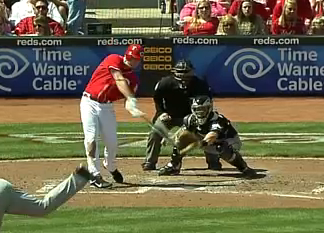


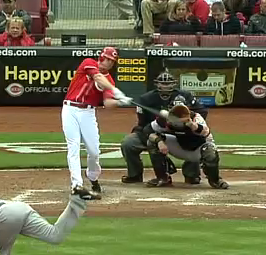
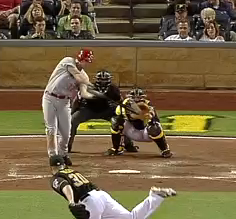
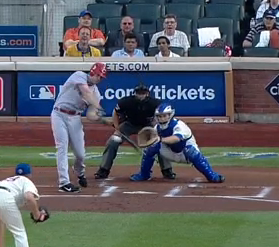




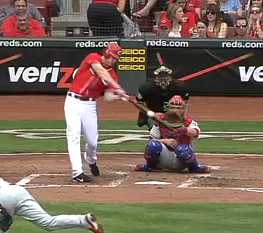


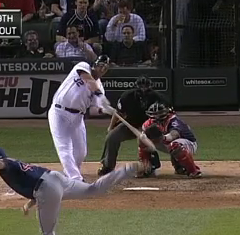



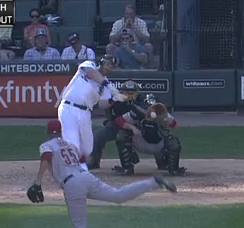





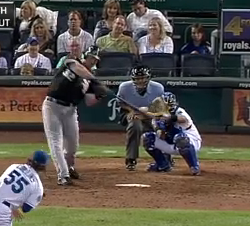

it’s hard to tell without a side view of these swings, but between Bruce and Dunn, it looks like Bruce might have a more vertical posture through the point of contact. Even with the lower pitch swings, Bruce seems to keep his upper body over the ball, while Dunn’s upper body arcs back into his stance earlier so his chest rotates towards the sky as he makes contact.
Wouldn’t it be awesome to see a selection of swing images like this per player profile page in a batted ball section? 🙂
Agreed, agreed and yes.